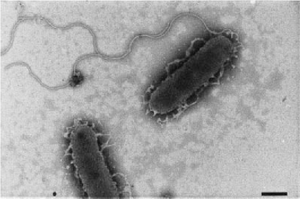Shewanella frigidimarina
Classification
Bacteria; Pseudomonadota; Gammaproteobacteria; Alteromonadales; Shewanellaceae
Species
|
NCBI: [1] |
Shewanella frigidimarina
Description and Significance
S. frigidimarina is a bacterial species that is motile, gram-negative, and rod-shaped. This psychrophilic species is found in a variety of habitats on the coast of Antarctica (Bozal et al., 2002). It is important to humans because of potential biomedical applications and to the environment because of its use in bioremediation (Sani et al., 2010).
Genome Structure
The genome is made up of about 4.8 million base pairs, with around 41% of that consisting of G & C. This genome exists within a single circular chromosome, although some extrachromosomal plasmids are present. It is very plastic due to the large abundance of mobile genetic elements (MGE) used to evolve and adapt (Parmeciano Di Noto et al., 2016).
Cell Structure, Metabolism and Life Cycle
S. frigidimarina is gram-negative, rod-shaped, and contains one unsheathed polar flagellum for motility. Young colonies are circular and mucoid, while older colonies can sometimes become filamentous (Bozal et al., 2002). This species is a chemo-organotrophic facultative anaerobe, exhibiting the ability to ferment carbohydrates and reduce iron to gain energy. When ferric compounds are present, this species produces c-cytochrome to reduce them (Fe(III) to Fe(II)) with DL-lactate as the electron donor (Reyes-Ramirez et al., 2003). With no oxygen present, this species can switch from aerobic respiration to fermentation. This process of fermentation produces polyunsaturated fatty acids, which have potential applications in health care and bioremediation of environments affected by petroleum hydrocarbons (due to events like fuel leaks) (Sani et al., 2010).
Ecology
This species inhabits the ice, water, and sediment along the coast of Antarctica. It lives freely in water and sediment as many other bacterial species do, but it produces special ice-binding proteins (IBP) in order to inhabit ice. The ice-binding domains of these proteins protrude from the bacteria's outer membrane to fix it to the surface of the ice (Vance et al., 2018).
References
Bozal, N., Montes, M. J., Tudela, E., Jiménez, F., & Guinea, J. (2002). Shewanella frigidimarina and Shewanella livingstonensis sp. nov. isolated from Antarctic coastal areas. International Journal of Systematic and Evolutionary Microbiology, 52(1), 195–205. https://doi.org/10.1099/00207713-52-1-195
Parmeciano Di Noto, G., Vázquez, S. C., MacCormack, W. P., Iriarte, A., & Quiroga, C. (2016). Draft genome of Shewanella frigidimarina AG06-30, a marine bacterium isolated from Potter Peninsula, king george island, Antarctica. Genome Announcements, 4(3). https://doi.org/10.1128/genomea.00289-16
Reyes-Ramirez, F., Dobbin, P., Sawers, G., & Richardson, D. J. (2003). Characterization of transcriptional regulation of Shewanella frigidimarina Fe(III)-induced Flavocytochrome c reveals a novel iron-responsive gene regulation system. Journal of Bacteriology, 185(15), 4564–4571. https://doi.org/10.1128/jb.185.15.4564-4571.2003
Sani, Y.M., Afegbua, S.L., Glassey, J., Ward, A.C., Rajarajan, N. (2010). Effect of growth media modifications on cell biomass and polyunsaturated fatty acids (PUFAs) production from Shewanella frigidimarina. African Journal of Biotechnology, 9(52), 8928-8933.
Vance, T. D. R., Graham, L. A., & Davies, P. L. (2018). An ice‐binding and tandem beta‐sandwich domain‐containing protein in Shewanella frigidimarina is a potential new type of ice adhesin. The FEBS Journal, 285(8), 1511–1527. https://doi.org/10.1111/febs.14424
Author
Page authored by Jacob Dehn, student of Prof. Bradley Tolar at UNC Wilmington.

